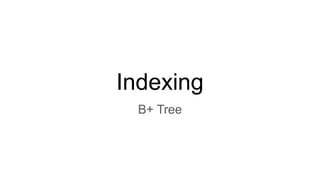Indexing & Hashing - Indexing using B+ Tree
- 2. B+ Tree Properties ● Every Tree has an order of “n” ● All nodes on the left have smaller values than a key and all nodes on the right have greater than or equal values than a key. Each node has the following properties Max Min Children root/internal: n Leaf: 0 Root: 2 (if root is not leaf as well) Internal: n/2 ⌈ ⌉ Keys/Values n-1 Root: 1 Leaf and Internal: n/2 -1 ⌈ ⌉ [Note: for simplicity leaf and internal is considered same in some resources, otherwise leaf min is (n-1)/2 ] ⌈ ⌉
- 3. B+ Tree (Insertion) Insertion Algorithm: 1. Find the right spot (leaf node): Start from the top (root) and move down the tree, following the correct path (based on the key you want to insert), until you reach a leaf node. 2. Insert if node has less than “max” keys: If that leaf node has space (less than the max number of keys allowed), just insert the value in sorted order.
- 4. B+ Tree (Insertion) 3. Split if node has “max” keys: If the leaf is already full, split it into half. Put first half on a new left leaf and the second half on a new right leaf. Send up the lowest key from the new right node to the parent 4. Repeat the split upwards if needed: If the parent now becomes full too, split it as well and push a key further up. If a non-leaf node is split, the lowest value on the right will only be moved up and not copied to the new right leaf. This might continue up to the root. If the root splits, a new root will be created and the tree height will increase.
- 5. B+ Tree (Insertion) Difference between splitting a leaf node vs a non-leaf(root/internal) node [for n= 4] Leaf Node Non-Leaf Node
- 6. B+ Tree (Insertion) Insert the following in a B+ tree of order 4 according to the given sequence: 4, 10, 7, 12, 1, 5, 2, 25, 15, 9, 18, 20 **Use the following B+ tree simulator ( https://www.cs.usfca.edu/~galles/visualization/BPlusTree.html) Here, max keys in a node = 4 - 1 = 3 1. Inserting 4, 10, 7 2. Inserting 12 3. Inserting 1
- 7. B+ Tree (Insertion) 4. Inserting 5 5. Inserting 2, 25 6.Inserting 15 7. Inserting 9, 18 8. Inserting 20
- 8. B+ Tree (Insertion) ● If the keys have String values, then sorting should be done according to the “dictionary” order. ● If order of B+ tree is odd (e.g. n=3), then create a right-biased or left-biased tree. Maintain the same bias for the entire tree. INSERTING 4, 10 , 7
- 9. B+ Tree (Deletion) CASE 1 (No. of Keys > “Min” Keys allowed) CASE 2 (No. of Keys = “Min” Keys allowed, Sibling Nodes have > “Min” Keys allowed) CASE 3 (No. of Keys = “Min” Keys allowed, Sibling Nodes also do not have “Min” Keys allowed) CASE 4 (Internal Nodes: No. of Keys = “Min” Keys allowed) CASE 5 (Shrinking of Tree)
- 10. B+ Tree (Deletion) CASE 1 (No. of Keys > “Min” Keys allowed) For n = 4, leaf/internal node min = n/2 -1 = 4/2 -1 = 1 ⌈ ⌉ ⌈ ⌉ Example 1: Delete 7 -> Find 7 (in leaf node and internal nodes) and remove
- 11. B+ Tree (Deletion) CASE 1 (No. of Keys > “Min” Keys allowed) Example 2: Delete 15 -> Find 15 (in leaf node and internal nodes) and remove. If removed from internal nodes, then replace with the lowest key from right subtree.
- 12. B+ Tree (Deletion) CASE 2 (No. of Keys = “Min” Keys allowed, Sibling Nodes have > “Min” Keys allowed) Example 1: Delete 12 -> Find key, borrow from left/right sibling through the parent. For internal nodes/parents, copy lowest key from right subtree.
- 13. B+ Tree (Deletion) CASE 2 (No. of Keys = “Min” Keys allowed, Sibling Nodes have > “Min” Keys allowed) Example 2: Delete 18 -> Find key, borrow from left/right sibling through the parent. For internal nodes/parents, copy lowest key from right subtree.
- 14. B+ Tree (Deletion) CASE 3 (No. of Keys = “Min” Keys allowed, Sibling Nodes also have only “Min” Keys allowed, Parent has greater than min allowed) Example 1: Delete 9 -> Find key, Merge with sibling, remove parent key (if Parent Node no.of keys> “Min” keys allowed)
- 15. B+ Tree (Deletion) CASE 4 (Internal Nodes: No. of Keys = “Min” Keys allowed) Example 1: Delete 25-> Find 20 in leaf and use case 3 since case 2 not possible. Now Parent has less than “min” no. of keys. Parent borrows from/merges with sibling and adjust children according to B+ properties. If internal nodes merge, they merge with sibling node and parent key.
- 16. B+ Tree (Deletion) CASE 5 (Shrinking of Tree: Same conditions as case 4) Example 1: Delete 20-> Find 20, use case 3 for leaf. For internal nodes, merge with sibling and parent, tree height will shrink if parent node has 1 key. Adjust children according to B+ tree properties.
- 17. Summary
- 18. Summary

![B+ Tree Properties
● Every Tree has an order of “n”
● All nodes on the left have smaller values than a key and all nodes on the right
have greater than or equal values than a key.
Each node has the
following properties
Max Min
Children root/internal: n
Leaf: 0
Root: 2 (if root is not leaf as well)
Internal: n/2
⌈ ⌉
Keys/Values n-1 Root: 1
Leaf and Internal: n/2 -1
⌈ ⌉
[Note: for simplicity leaf and internal is
considered same in some resources,
otherwise leaf min is (n-1)/2 ]
⌈ ⌉](https://image.slidesharecdn.com/indexingusingbtree-250523140357-ad2f3b54/85/Indexing-Hashing-Indexing-using-B-Tree-2-320.jpg)


![B+ Tree (Insertion)
Difference between splitting a leaf node vs a
non-leaf(root/internal) node [for n= 4]
Leaf Node
Non-Leaf Node](https://image.slidesharecdn.com/indexingusingbtree-250523140357-ad2f3b54/85/Indexing-Hashing-Indexing-using-B-Tree-5-320.jpg)












